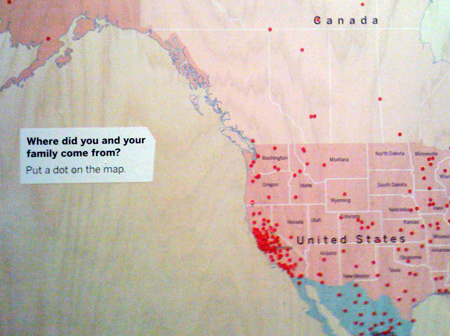Crowdsourced mapping
Nan Barnes
I’m still reflecting on my recent trip to the Oakland Museum, and how we can apply the methods used by these curators of culture in our own learning. In my last post on the subject, I talked about their interactive timeline.
The interactive map below is another example of using the information provided by a large group. How simple – a map, and stickers. In this case, the question is, “Where did your family come from?” Yet there are other questions you might ask, such as where have you traveled to, or where did your ancestors live in the 1600’s – each of which would produce wildly different data. You can do this - anyone can.

The graphic doesn’t have to be a map, either. Like the timeline I discussed earlier, these are just representations of the scope of the question we’re asking. If we want to know about places, maps are good. Time? You get it. The key is the ease with which people can give their answer. That’s what is clever here – a sticker, or a post it note is very user friendly. And the internet has made this kind of data collection even easier.
I first fell in love with the idea of crowdsourcing when Wikipedia appeared ten years ago. It seems the ideal way to tap into the knowledge of the masses. Crowdsourcing is controversial - in this Wikipedia article about crowdsourcing, I just discovered that Wikipedia founder Jimmy Wales objects to the term. It has a negative connotation of taking advantage of free labor. (If you have a moment, check out the article’s list of terms related to crowdsourcing, including citizen science, collective intelligence, and a new one to me – dotmocracy.
So this most commonly used term, crowdsourcing, is a misnomer. Instead, the admirable model used at the museum would be called mass collaboration, or mass cooperation. That’s what’s happening on Wikipedia, and in different iterations it’s happening everywhere else, too. I always read the user reviews on amazon.com before I buy, and I’m careful to check that the majority rated the book highly. Don’t you? I filter my Yelp! searches so that I only need to consider 4-star restaurants. My favorite use of crowdsourcing (sorry, the term is imprecise, but you know what I mean) is the excellent user reviews on newegg.com, without which I could not navigate the world of technology.
The thing that ties these examples together is the absence of “experts”. It assumes that all of us have useful knowledge to share. The charm of crowdsourcing is that no one can force people to contribute; and yet people do, willingly. We are happy to help, happy to give what knowledge we have, especially when it’s a subject we care about.
The interactive map in the museum is just the tip of the iceberg – a literal, hands-on sign that people are willing to contribute. If you want to frame a question, any question, posting it to an well-chosen internet bulletin board will gather results from masses of distant strangers – and isn’t that something to bolster your faith in humanity?